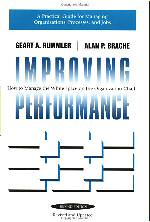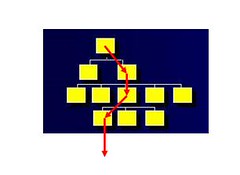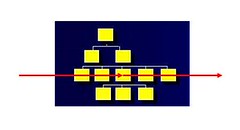Wednesday, March 23, 2005
Fierce winds knocked down a power line in Berkeley in the wee hours of Tuesday morning. Smokey the canine alarm clock insisted that I get out of bed at 7:00 am even though the lights weren't back on. I lit a candle and stood at my drawing board mapping a simpler explanation of what workflow learning is all about. I thought myself a modern-day Abraham Lincoln, studying by flickering candelight and forced to heat my coffee water on the gas grill on the deck. Falling off the grid was like slipping into a sensory-deprivation tank. No interruptions.
 Before long I was flipping through Rummler and Brache's Improving Performance: How to Manage the White Space on the Organization Chart. Intuition told me it was time to dig into this book. No, despite the fact that it has been out for a decade, I hadn't read it before. My copy is from the library at the Haas School of Business.
Before long I was flipping through Rummler and Brache's Improving Performance: How to Manage the White Space on the Organization Chart. Intuition told me it was time to dig into this book. No, despite the fact that it has been out for a decade, I hadn't read it before. My copy is from the library at the Haas School of Business.
What a wonderful book! This is a powerful tome, way ahead of its time: deep truth. Few of the concepts are new to me but now I know where they came from. The book is concentrated -- every sentence counts. Yet it is also clear, even when hitting the heavy parts of organizational design.
Rummler and Brache (hereafter, R & B) apply a systems view to improving performance in business organizations. They contend that most managers don't understand their own businesses. The managers may know their products and their customers, but they don't know the processes where raw material is converted into products nor how those products are sold or distributed. In fact, they often manage the organization chart (a verticle slice) instead of the business (which is the value chain flowing horizontally).
R & B present a 3x3 matrix with Performance Needs (Goals, Design, and Management) along one axis and Levels of Performance (Organization, Process, and Performer) along the other. The bulk of the book explores each cell, e.g. Organization Design or Process Management.
I know this framework from piecing ideas together from other sources such as Deming, Forrester, Geis, Gilbert, Hammer, Keen, Kepner-Tregoe, Mager, Porter, Senge, Wiener, and, lately, Business Process Management. What I hadn't seen was R&B's wonderful synthesis.
Back to workflow learning. People ask me about the difference between workflow learning and EPSS. A key aspect is that workflow learning connects more directly with R&B's process layer.
Study after study finds that among organizations that "manage the organization chart instead of the work," less than 20% of workers' and supervisors' time is spent adding value to work product. 80% of work time is wasted on waiting, inefficiencies, busywork, and window dressing.

R&B tell us, "The greatest opportunites for performance improvement often lie in the functional interfaces--those points at which the baton (for example, 'production specs') is being passed from one department to another...."
I'll close with a couple of zingers from Improving Performance:
Amazon: Improving Performance
To recap, here is the typical, functional way of getting things done:

The danger in this is that optimizing the parts (the functions) does not optimize the whole (the organization) because no one is responsible for the flow of value between functions. Hence, we should focus on optimizing the performance of a value chain that cuts across functions (and both starts and ends outside of the organization.)

I.e., go with the flow.
 Before long I was flipping through Rummler and Brache's Improving Performance: How to Manage the White Space on the Organization Chart. Intuition told me it was time to dig into this book. No, despite the fact that it has been out for a decade, I hadn't read it before. My copy is from the library at the Haas School of Business.
Before long I was flipping through Rummler and Brache's Improving Performance: How to Manage the White Space on the Organization Chart. Intuition told me it was time to dig into this book. No, despite the fact that it has been out for a decade, I hadn't read it before. My copy is from the library at the Haas School of Business.What a wonderful book! This is a powerful tome, way ahead of its time: deep truth. Few of the concepts are new to me but now I know where they came from. The book is concentrated -- every sentence counts. Yet it is also clear, even when hitting the heavy parts of organizational design.
Rummler and Brache (hereafter, R & B) apply a systems view to improving performance in business organizations. They contend that most managers don't understand their own businesses. The managers may know their products and their customers, but they don't know the processes where raw material is converted into products nor how those products are sold or distributed. In fact, they often manage the organization chart (a verticle slice) instead of the business (which is the value chain flowing horizontally).
R & B present a 3x3 matrix with Performance Needs (Goals, Design, and Management) along one axis and Levels of Performance (Organization, Process, and Performer) along the other. The bulk of the book explores each cell, e.g. Organization Design or Process Management.
I know this framework from piecing ideas together from other sources such as Deming, Forrester, Geis, Gilbert, Hammer, Keen, Kepner-Tregoe, Mager, Porter, Senge, Wiener, and, lately, Business Process Management. What I hadn't seen was R&B's wonderful synthesis.
Back to workflow learning. People ask me about the difference between workflow learning and EPSS. A key aspect is that workflow learning connects more directly with R&B's process layer.
When we look beyond the functional boundries that make up the organization chart, we can see the work flow--how the work gets done. We contend that organizations produce their outputs through myriad cross-functional work processes, such as the new-product design process, the merchandising process, the production process, the sales process, the distribution process, and the billing process (to name a very few.) An organization is only as good as its processes.The coming generation of IT, Web Services, enables organizations to connect performers directly to processes. The worker can monitor work at the process level as it happens. This used to involve huge delays, for example reading the report about how things looked last week. In the future, workers will get readouts of workflow status in near real time. This is revolutionary. The potential payoff is HUGE.
Study after study finds that among organizations that "manage the organization chart instead of the work," less than 20% of workers' and supervisors' time is spent adding value to work product. 80% of work time is wasted on waiting, inefficiencies, busywork, and window dressing.

R&B tell us, "The greatest opportunites for performance improvement often lie in the functional interfaces--those points at which the baton (for example, 'production specs') is being passed from one department to another...."
A primary contribution of a manager (at the second level or above) is to manage interfaces. The boxes already have managers; the senior manager adds value by managing the white space bwtween the boxes.Workflow learning connects worker and dynamic value chain. I'm parsing earlier definitions of workflow learning into a core definition, principles of best practice, the organization as ecosystem, and the future IT environment. There's a pony in there somewhere. R&B have clarified my thinking.
I'll close with a couple of zingers from Improving Performance:
Silo culture forces managers to resolve lower-level issues, taking their time away from higher-priority customer and competitor concerns. Individual contributors, who could be resolving these issues, take less responsibility for results and perceive themselves as mere implementers and information providers.
- - - - -
Evaluating training in a vacuum is a waste of time. A training program may have well-stated learning outcomes, appropriate media, excellent materials, and effective instruction. However, if the training addresses the wrong performance area, is not reinforced by Consequences and Feedback, is not supported by a well-designed work process, or is not linked to the direction of the organization, it is not worth the investment. With typical methods of evaluation, a workshop could win awards for instructional design the same week tha the company files for Chapter 11 protection. Performance impact evaluation, by contrast, does not allow a course to look good without its also having a significant impact on the performance of the business.
Amazon: Improving Performance
To recap, here is the typical, functional way of getting things done:

The danger in this is that optimizing the parts (the functions) does not optimize the whole (the organization) because no one is responsible for the flow of value between functions. Hence, we should focus on optimizing the performance of a value chain that cuts across functions (and both starts and ends outside of the organization.)

I.e., go with the flow.









0 Comments:
Post a Comment
<< Home